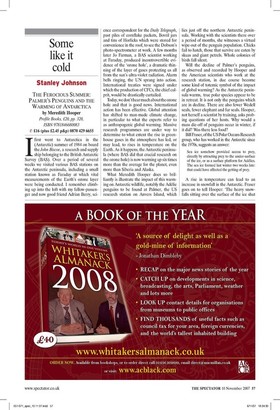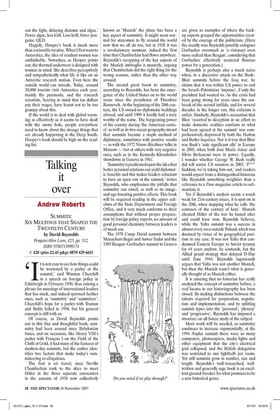Some like it cold
Stanley Johnson THE FEROCIOUS SUMMER: PALMER'S PENGUINS AND THE WARMING OF ANTARCTICA by Meredith Hooper Profile Books, £20, pp. 320, ISBN 9781846680083 £16 (plus £2.45 p&p) 0870 429 6655 Ifirst went to Antarctica in the (Antarctic) summer of 1984 on board the John Biscoe, a research and supply ship belonging to the British Antarctic Survey (BAS). Over a period of several weeks we visited various BAS stations on the Antarctic peninsula, including a small station known as Faraday at which vital measurements of the Earth's ozone layer were being conducted. I remember climbing up into the loft with my fellow-passenger and now good friend Adrian Berry, science correspondent for the Daily Telegraph, past piles of cornflake packets, Bovril jars and tins of Horlicks which were stored for convenience in the roof, to see the Dobson's photo-spectrometer at work. A few months later Jo Farman, a BAS scientist working at Faraday, produced incontrovertible evidence of the 'ozone hole', a dramatic thinning of the layer of gases protecting us all from the sun's ultra-violet radiation. Alarm bells ringing, the UN sprang into action. International treaties were signed under which the production of CFCs, the chief culprit, would be drastically curtailed.
Today, we don't hear much about the ozone hole and that is good news. International action has been effective. Global attention has shifted to man-made climate change, in particular to what the experts refer to as anthropogenic global warming. Massive research programmes are under way to determine to what extent the rise in greenhouse gases in the atmosphere has led, or may lead, to rises in temperature on the Earth. As it happens, the Antarctic peninsula (where BAS did that crucial research on the ozone hole) is now warming up six times more than the average for the planet, even more than Siberia and Alaska.
What Meredith Hooper does so brilliantly is illustrate the impact of this warming on Antarctic wildlife, notably the Adelie penguins to be found at Palmer, the US research station on Anvers Island, which lies just off the northern Antarctic peninsula. Working with the scientists there over a period of months, she witnesses a virtual wipe-out of the penguin population. Chicks fail to hatch, those that survive are eaten by skuas and giant petrels. Whole colonies of birds fall silent.
Will the decline of Palmer's penguins, as observed and recorded by Hooper and the American scientists who work at the research station, in due course become some kind of totemic symbol of the impact of global warming? As the Antarctic peninsula warms, true polar species appear to be in retreat. It is not only the penguins which are in decline. There are also fewer Wedell seals, fewer elephant and fur seals. Hooper, not herself a scientist by training, asks probing questions of her hosts. Why would a mass die-off of penguins occur in winter, if it did? Was there less food?
Bill Fraser, of the US Polar Oceans Research group, who has worked in the Antarctic since the 1970s, suggests an answer: Sea ice somehow provided access to prey, directly by attracting prey to the under-surface of the ice, or as a surface platform for Adelies. The sea ice formed last winter two weeks late: that could have affected the getting of prey.
A rise in temperature can lead to an increase in snowfall in the Antarctic. Fraser goes on to tell Hooper: 'The heavy snowfalls sitting over the surface of the ice shut out the light, delaying diatoms and algae.' Fewer algae, less krill. Less krill, fewer penguins. QED.
Happily, Hooper's book is much more than a scientific treatise. When I first went to Antarctica, the idea of resident women was unthinkable. Nowadays, as Hooper points out, the thermal underwear is designed with women in mind. She describes perceptively and sympathetically what life is like on an Antarctic research station. Even here the outside world can intrude. Today, around 30,000 tourists visit Antarctica each year, mainly the peninsula, and the research scientists, bearing in mind that tax dollars pay their wages, have learnt not to be too grumpy about this.
If the world is to deal with global warming as effectively as it seems to have dealt with the ozone hole, people everywhere need to know about the strange things that are already happening in the Deep South. Hooper's book should be high on the reading list.






































































 Previous page
Previous page